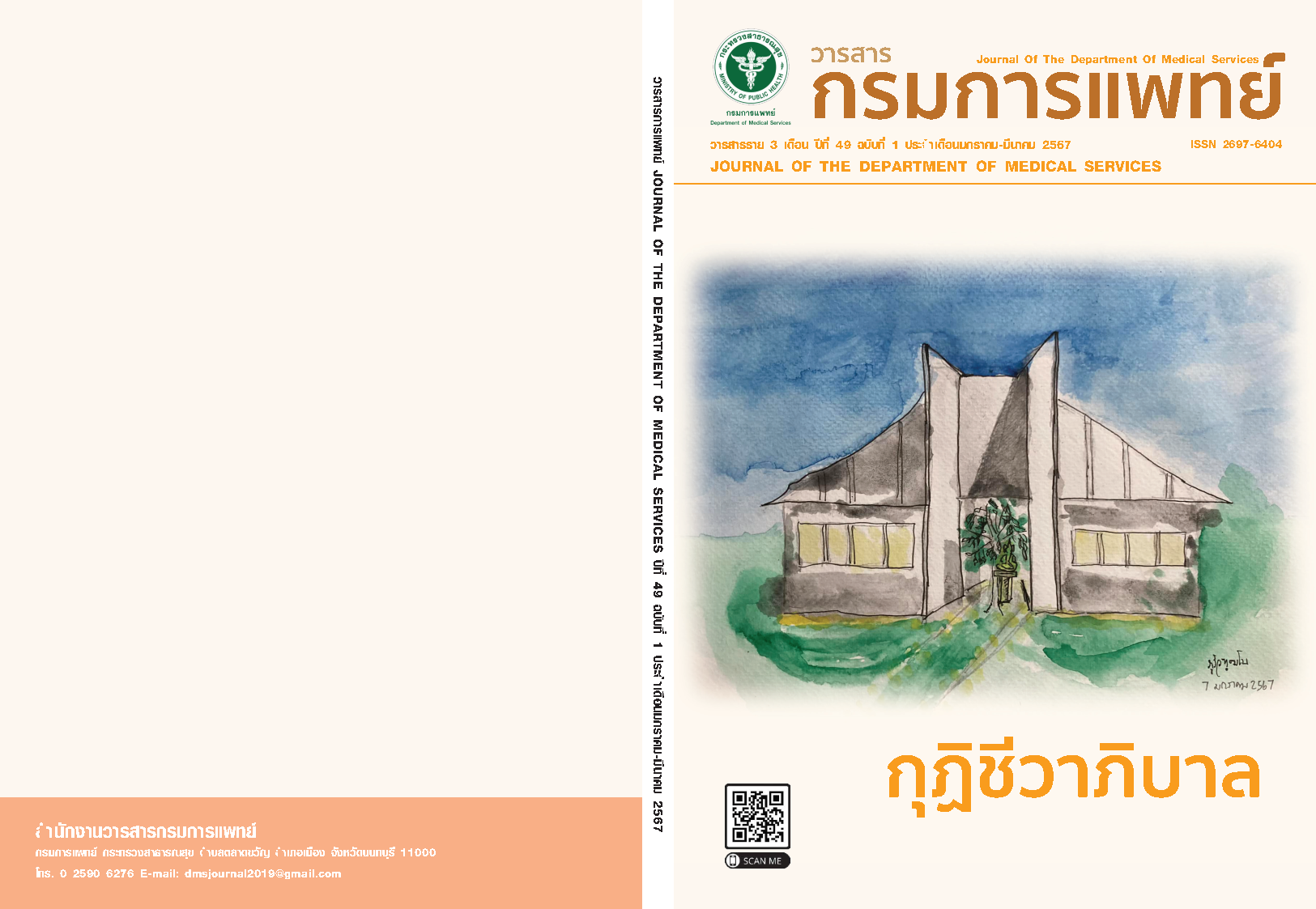ปัจจัยเสี่ยงของภาวะหัวใจห้องบนเต้นเร็วผิดปกติในผู้ป่วยที่ได้รับการรักษาด้วยเครื่องกระตุ้นหัวใจแบบถาวรในสถาบันโรคทรวงอก
คำสำคัญ:
ภาวะหัวใจห้องบนเต้นเร็วผิดปกติ, หัวใจห้องบนสั่นพลิ้ว, เครื่องกระตุ้นหัวใจ, สมองขาดเลือด, ปัจจัยส่งเสริมบทคัดย่อ
ภูมิหลัง: ภาวะหัวใจห้องบนเต้นเร็วผิดปกติได้รับการพิจารณาว่ามีความสัมพันธ์ทางคลินิกต่อการเกิดหัวใจห้องบนสั่นพลิ้ว นอกจากนี้ ความเสี่ยงต่อการเกิดสมองขาดเลือดยังเพิ่มขึ้นตามภาวะหัวใจห้องบนเต้นเร็วผิดปกติและ/หรือระดับคะแนนของ CHA2 DS2 -VASc ที่เพิ่มขึ้น อย่างไรก็ตาม ปัจจัยที่ส่งเสริมให้เกิดภาวะหัวใจห้องบนเต้นเร็วผิดปกติยังไม่เป็นที่ทราบแน่ชัด วัตถุประสงค์: เพื่อศึกษาปัจจัยที่ส่งเสริมการเกิดภาวะหัวใจห้องบนเต้นเร็วผิดปกติในผู้ป่วยที่ใส่เครื่องกระตุ้นหัวใจแบบสองห้อง วิธีการ: การศึกษานี้เป็นการศึกษาแบบสังเกตการณ์ย้อนหลังในผู้ป่วยที่ไม่ได้มีประวัติเป็นหัวใจห้องบนสั่น พลิ้วมาก่อนใส่เครื่องกระตุ้นหัวใจแบบสองห้องผู้ป่วยที่ตรวจพบหัวใจห้องบนผิดจังหวะชนิดอื่น ๆ จะได้รับการตัดออกจากการศึกษา ข้อมูลผู้ป่วยพื้นฐาน, ประวัติโรคประจำตัว, ยาที่ได้รับ, ผลการตรวจคลื่นเสียงสะท้อนหัวใจ, ผลการตรวจคลื่นไฟฟ้าหัวใจ และข้อมูลการตรวจเครื่องกระตุ้นหัวใจได้รับการวิเคราะห์และเปรียบเทียบระหว่างผู้ป่วยที่มีและไม่มีภาวะหัวใจห้องบนเต้นเร็วผิดปกติ ปัจจัยส่งเสริมที่ทำนายการเกิดภาวะหัวใจห้องบนเต้นเร็วผิดปกติได้รับการวิเคราะห์โดยใช้การวิเคราะห์ถดถอยเอกนามและพหุนาม ผล: ผู้ป่วยจำนวน 239 คน ที่ได้รับการใส่เครื่องกระตุ้นหัวใจแบบสองห้องในสถาบันโรคทรวงอกระหว่างมกราคม พ.ศ. 2560 ถึงธันวาคม พ.ศ. 2564 ได้รับการคัดเลือกเข้าสู่การศึกษา ข้อมูลของผู้ป่วยจำนวน 117 คน จากผู้ป่วยทั้งหมด 239 คน ได้รับการวิเคราะห์ โดยมีผู้ป่วยจำนวน 89 คนที่ไม่มีภาวะหัวใจห้องบนเต้นเร็วผิดปกติและ 28 คนที่มีภาวะหัวใจห้องบนเต้นเร็วผิดปกติ การวิเคราะห์ถดถอยพหุนามแสดงให้เห็นว่าเปอร์เซ็นต์ของการกระตุ้นหัวใจห้องบนมากกว่า ในกลุ่มผู้ป่วยที่มีภาวะหัวใจห้องบนเต้นเร็วผิดปกติอย่างมีนัยสำคัญทางสถิติ (odds ratio 1.02; 95% CI 1.003 to 1.041; p-value = .021) สรุป: การกระตุ้นหัวใจห้องบนที่เพิ่มขึ้นเป็นปัจจัยส่งเสริมเดียวต่อการเกิดภาวะหัวใจห้องบนเต้นเร็วผิดปกติในผู้ป่วยไทยที่ใส่เครื่องกระตุ้นหัวใจแบบถาวร อย่างไรก็ตาม การศึกษาแบบไปข้างหน้าขนาดใหญ่ควรมีการศึกษาต่อไปในอนาคต
เอกสารอ้างอิง
Rapsang AG, Bhattacharyya P. Pacemakers and implantable cardioverter defibrillators--general and anesthetic considerations. Braz J Anesthesiol 2014;64 (3):205-14.
Greenspan AJ, Patel JD, Lau E, Ochoa JA, Frisch DR, Ho RT, et al. Trends in permanent pacemaker implantation in the United States from 1993 to 2009: increasing complexity of patients and procedures. J Am Coll Cardiol 2012;60(16):1540-5.
Bernsein AD, Daubert JC, Fletcher RD, Hayes DL, Lüderitz B, Reynold DW, et al. The revised NASPE/BPEG generic code for antibradycardia, adaptive-rate, and multisite pacing. North American Society of pacing and electrophysiology/British pacing and electrophysiology group. Pacing Clin Electrophysiol 2002;25(2):260-4.
Epstein AE, DiMarco JP, Ellenbogen KA, Estes 3rd NAM, Freedman RA, Gettes LS, et al. 2012 ACCF/ AHA/HRS focused update incorporated into the ACCF/AHA/ HRS 2008 guidelines for device-based therapy of cardiac rhythm abnormalities: a report of the American College of Cardiology Foundation/American Heart Association Task Force on practice guidelines and the Heart Rhythm Society. J Am Coll Cardiol 2013;61(3):e6-75.
Stone ME, Salter B, Fischer A. Perioperative management of patients with cardiac implantable electronic devices. Br J Anaesth 2011;107(Suppl 1):i16-26.
Glotzer TV, Hellkamp AS, Zimmerman J, Sweeney MO, Yee R, Marinchak R, et al. Atrial high rate episodes detected by pacemaker diagnostics predict death and stroke: report of the Atrial Diagnostics Ancillary Study of the MOde Selection Trial (MOST). Circulation 2003; 107(12):1614-9.
Hindricks G, Potpara T, Dagres N, Arbelo E, Bax JJ, Blomström-Lundqvist C, et al. 2020 ESC Guidelines for the diagnosis and management of atrial fibrillation developed in collaboration with the European Association of Cardio-Thoracic Surgery (EACTS). Eur Heart J 2020;42(5):373-498.
Khan AA, Boriani G, Lip GYH. Are atrial high rate episodes (AHREs) a precursor to atrial fibrillation? Clin Res Cardiol 2020;109(4):409-16.
Bertaglia E, Blank B, Blomström-Lundqvist C, Brandes A, Cabanelas N, Dan GA, et al. Atrial highrate episodes: prevalence, stroke risk, implications for management, and clinical gaps in evidence. Europace 2019;21(10):1459-67.
Boriani G, Vitolo M, Imberti JF, Potpara TS, Lip GYH. What do we do about atrial high rate episodes? Eur Heart J Suppl 2020;22(Suppl O):O42-O52.
Mahajan R, Perera T, Elliott AD, Twomey DJ, Kumar S, Munwar DA, et al. Subclinical device-detected atrial fibrillation and stroke risk: a systematic review and meta- analysis. Eur Heart J 2018;39(16):1407–15.
Healey JS, Connolly SJ, Gold MR, Israel CW, Van Gelder IC, Capucci A, et al. Subclinical atrial fibrillation and the risk of stroke. N Engl J Med 2012;366(2):120–9.
Chen JH, Chen GY, Zheng H, Chen QH, Fu FY, Zhang FL, et al. Atrial high-rate event incidence and predictors in patients with permanent pacemaker implantation. Front Cardiovasc Med 2021;8:728885.
Miyazawa K, Pastori D, Martin DT, Choucair WK, Halperin JL, Lip GYH. Characteristics of patients with atrial high rate episodes detected by implanted defibrillator and resynchronization devices. Europace 2022;24(3):375-83.
Healey JS, Alings M,Ha A, Leong-Sit P, Birnie DH, de Graaf JJ, et al. Subclinical atrial fibrillation in older patients. Circulation 2017;136(14):1276-83.
ดาวน์โหลด
เผยแพร่แล้ว
รูปแบบการอ้างอิง
ฉบับ
ประเภทบทความ
สัญญาอนุญาต
ลิขสิทธิ์ (c) 2024 กรมการแพทย์ กระทรวงสาธารณสุข

อนุญาตภายใต้เงื่อนไข Creative Commons Attribution-NonCommercial-NoDerivatives 4.0 International License.
บทความที่ได้รับการตีพิมพ์เป็นลิขสิทธิ์ของกรมการแพทย์ กระทรวงสาธารณสุข
ข้อความและข้อคิดเห็นต่างๆ เป็นของผู้เขียนบทความ ไม่ใช่ความเห็นของกองบรรณาธิการหรือของวารสารกรมการแพทย์



